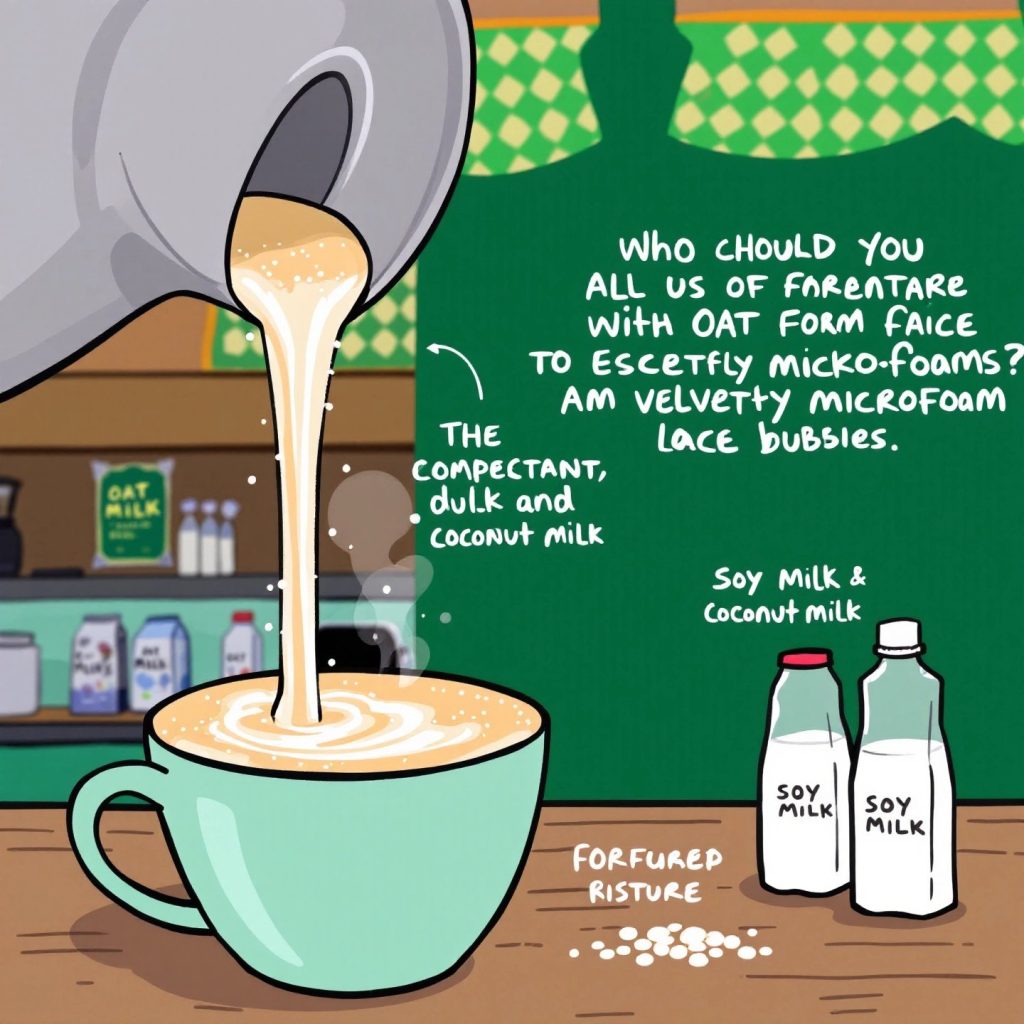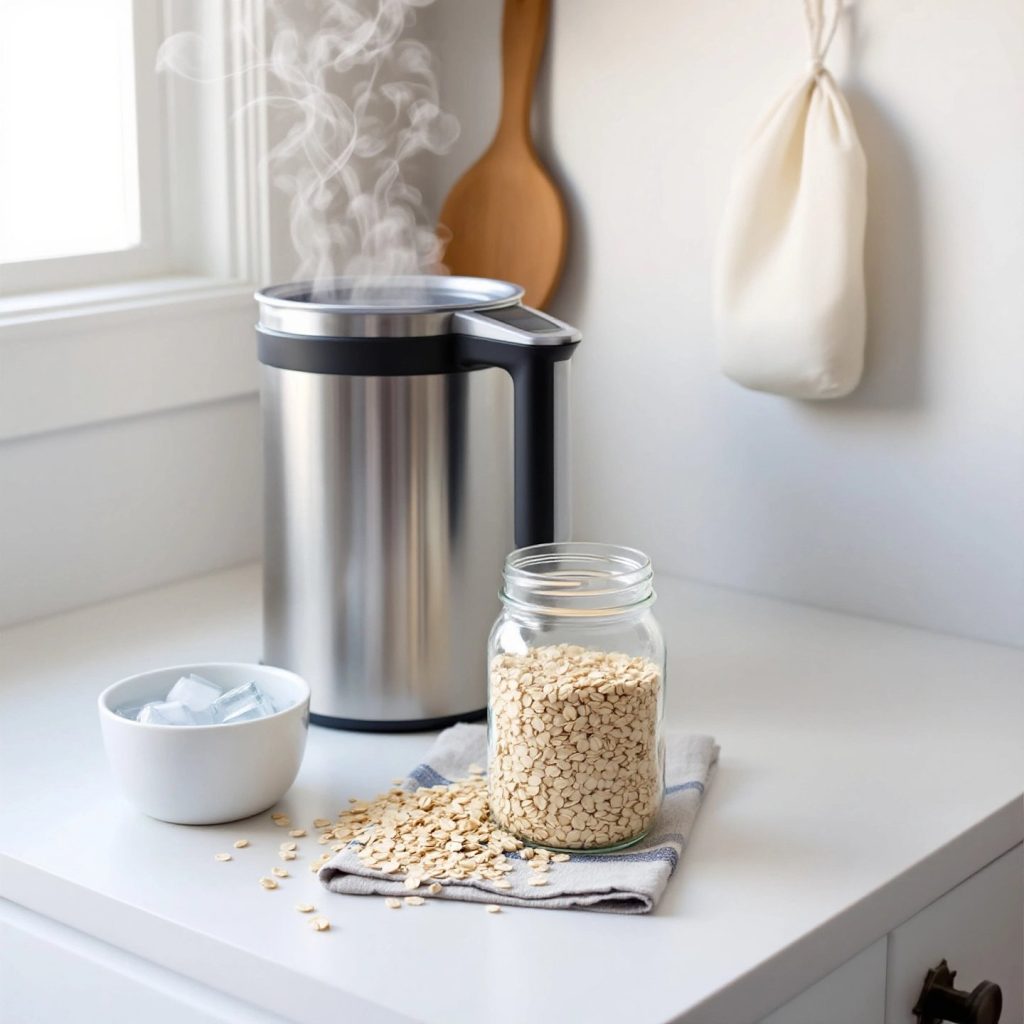Introduction: The Rise of Non-Dairy Milk in Coffee Culture
In recent years, the coffee culture has seen a significant shift towards non-dairy milk alternatives, driven by both health-conscious consumers and those seeking to reduce their environmental footprint. As plant-based diets gain popularity, so does the demand for non-dairy milk options that can replicate the creamy, frothy texture traditionally achieved with dairy milk. This trend is not just a fleeting fad; the plant milk industry is projected to grow by 15% annually, reaching a market value of over $120 billion by 2030, according to a report from Intelligence Coffee.
Among the various non-dairy milk alternatives, almond, oat, soy, and coconut milk have emerged as the frontrunners in coffee shops and homes alike. Each offers unique flavors and frothing capabilities, appealing to a diverse range of taste preferences and dietary needs. However, the quest for the best plant milk for frothing is not without its challenges. Factors such as protein and fat content significantly influence the ability of these milks to produce a stable foam, which is crucial for creating intricate latte art and achieving the perfect cappuccino texture.
As more consumers embrace non-dairy options, understanding the nuances of frothing with plant-based milks becomes essential. This comprehensive guide will explore the science behind milk frothing and provide insights into the best non-dairy milk alternatives for coffee, setting you on the path to perfecting your plant-based latte art.
Understanding Milk Frothing: What Makes a Good Froth?
The art of milk frothing is a delicate balance of science and technique, crucial for crafting the perfect coffee experience. At its core, frothing milk involves creating a stable foam, which is primarily influenced by the milk’s protein and fat content. Proteins, such as whey and casein, play a pivotal role in forming and stabilizing the foam structure. When milk is heated, these proteins denature, allowing them to trap air and create bubbles, leading to a creamy froth. However, overheating can cause proteins to break down, resulting in a less stable foam.
Fats also significantly impact frothing. In dairy milk, higher fat content generally results in a richer, creamier froth, although it may be less voluminous compared to lower-fat options. Non-dairy milks, however, vary widely in their protein and fat compositions, influencing their frothing capabilities. For instance, almond milk tends to have lower protein content, which can make achieving a stable froth more challenging compared to soy or oat milk, which typically offer higher protein levels.
Enter the realm of ‘barista blends’, specially formulated non-dairy milks designed to enhance frothing performance. These blends often include added proteins or fats to mimic the frothing properties of dairy milk, providing a more consistent and stable foam. As noted by MILKLAB, barista blends are crafted to withstand high temperatures without curdling, ensuring a silky texture that complements the coffee without overpowering it.
Understanding these scientific principles not only aids in selecting the best non-dairy milk for frothing but also enhances the overall coffee experience. As we delve deeper into specific milk types, the nuances of frothing will become clearer, guiding you to make informed choices for your next plant-based latte.

Barista creating latte art with frothy almond milk (AI-generated)
Almond Milk: The Popular Choice for Frothing
Almond milk has carved out a niche as a preferred non-dairy option for coffee enthusiasts seeking a frothy, creamy texture without the use of dairy. But does almond milk froth well? The answer is a resounding yes, albeit with some considerations. Almond milk, while lower in protein compared to other plant-based milks like soy, can still produce a stable and appealing foam, especially when using varieties specifically formulated for barista purposes.
The frothing success of almond milk largely hinges on its fat and protein content. Higher fat content generally aids in creating a richer froth, while proteins help stabilize the foam. As noted by Texanerin Baking, almond milk requires a slightly higher temperature to froth effectively compared to dairy milk. This is because the proteins in almond milk need to be denatured at a higher temperature to trap air effectively and form bubbles.
Pros and Cons of Frothing Almond Milk
One of the main advantages of using almond milk is its light, nutty flavor, which can enhance the coffee’s natural aromas without overpowering them. It is also a low-calorie option, making it suitable for those watching their caloric intake. However, the froth produced by regular almond milk might not be as creamy or stable as that of dairy milk unless you opt for a barista blend, which is specifically formulated to improve frothing performance by adjusting the protein and fat content.
Choosing the Right Almond Milk for Frothing
When selecting almond milk for frothing, consider brands that offer barista blends. These are designed with frothing in mind, incorporating additional proteins and stabilizers to enhance performance. Popular brands like Califia Farms Barista Blend and Pacific Foods Organic Almond Milk are known for their frothing capabilities. As with any non-dairy milk, results can vary, so experimenting with different brands may be necessary to find the best almond milk for latte art.
Tips for Frothing Almond Milk
To achieve the best froth with almond milk, pay attention to the temperature. Heat the milk to just below boiling, around 150°F (65°C), to ensure the proteins denature properly without curdling. Use a steam wand or a dedicated milk frother for the best results, and avoid overheating, which can lead to a chunky texture. With these tips in mind, almond milk can be a delightful addition to your frothy coffee repertoire, offering a creamy texture and subtle flavor that complements your favorite brews.
As we continue exploring non-dairy milk options, oat milk emerges as another strong contender, beloved by baristas for its superior frothing qualities and creamy texture.

Oat milk microfoam compared with other non-dairy options (AI-generated)
Oat Milk: The Barista’s Favorite for Frothing
Oat milk has rapidly gained popularity among coffee aficionados and baristas alike, celebrated for its remarkable frothing capabilities and creamy texture. Unlike some other non-dairy options, oat milk offers a consistency and taste that closely mimic traditional dairy milk, making it an ideal choice for crafting luxurious coffee beverages. Its superior frothing qualities stem from its unique composition, which includes a balanced blend of proteins and fats that contribute to a stable and velvety foam.
Why Oat Milk Excels in Frothing
Among the various plant-based milks, oat milk stands out due to its ability to produce a rich and creamy foam that enhances the texture of lattes and cappuccinos. According to Corner Coffee Store, oat milk’s thickness and creaminess make it particularly suitable for frothing, offering a mouthfeel that closely resembles that of cow’s milk. This makes it a preferred choice for those looking to replicate the traditional coffee experience without dairy.
One of the key reasons oat milk froths so well is its high carbohydrate content, which contributes to its creamy texture and ability to hold air when frothed. Additionally, oat milk often contains added enzymes that break down the oats, enhancing its natural sweetness and frothing properties.
Comparing Popular Oat Milk Brands
When it comes to choosing the best oat milk for frothing, several brands have established themselves as frontrunners. Methodical Coffee highlights Oatly Barista Edition as a top choice due to its ability to create a lovely foam that coats the tongue, similar to whole cow’s milk. Califia Farms also offers a barista blend specifically designed for coffee, praised for its easy frothing and ability to complement a variety of coffee drinks.
Each brand offers unique characteristics, with some adding stabilizers or extra fats to improve frothing performance. For instance, Silk’s oat milk is noted for its smooth texture and slight sweetness, making it suitable for both hot and cold beverages.
Oat Milk vs. Other Non-Dairy Options
Compared to almond or soy milk, oat milk’s frothing behavior is distinct. Its natural creaminess and ability to produce microfoam make it particularly effective for creating latte art, a feature that baristas value highly. Unlike almond milk, which may require higher temperatures to froth effectively, oat milk froths easily without the risk of curdling.
As you explore the world of non-dairy milks, oat milk’s frothing superiority and delightful taste make it an excellent choice for any coffee enthusiast. Whether you’re crafting a frothy cappuccino or a silky latte, oat milk provides a satisfying, dairy-free experience that rivals traditional options. Next, we’ll delve into the classic choice of soy milk and its role in the frothing landscape.
Soy Milk: The Classic Non-Dairy Frothing Option
Soy milk holds a prominent place in the world of coffee, known for its ability to froth well and complement a variety of coffee drinks. As one of the earliest non-dairy alternatives to gain popularity in coffee shops, soy milk continues to be a favorite due to its rich protein content, which plays a crucial role in creating a stable and creamy foam.
One of the standout features of soy milk is its protein content, which is comparable to that of cow’s milk. This high protein level is instrumental in stabilizing the froth, allowing soy milk to produce a thick and substantial foam, making it ideal for crafting lattes and cappuccinos. The protein in soy milk helps trap air bubbles effectively, resulting in a froth that is both creamy and long-lasting, enhancing the overall texture of your coffee beverage.
Advantages and Drawbacks of Frothing with Soy Milk
When it comes to frothing, soy milk offers several advantages. Its ability to create a stable foam with good volume makes it a reliable choice for those looking to replicate the texture of dairy milk in their coffee drinks. Additionally, soy milk’s neutral flavor profile allows it to blend seamlessly with the flavors of coffee, without overpowering them.
However, there are some potential drawbacks to consider. Some individuals may find the taste of soy milk to be distinctive, with a slight bean-like flavor that may not appeal to everyone. Moreover, for those with soy allergies or sensitivities, soy milk is not an option. It’s important to note that some brands may use additives or sweeteners to enhance flavor and frothability, so checking labels is advisable for those concerned about ingredients.
Choosing the Best Soy Milk for Frothing
When selecting soy milk for frothing, it’s beneficial to opt for a variety specifically formulated for barista use, as these are designed to enhance frothing performance. Brands like Pacific Foods and Silk offer barista blends that are tailored to create a smooth, glossy microfoam, perfect for latte art. These blends typically contain added stabilizers that improve the frothing process, ensuring a consistent and creamy foam.
As you explore the world of non-dairy milks, soy milk stands out as a classic choice with a proven track record in frothing. Its protein-rich composition and ability to produce stable foam make it a dependable option for coffee enthusiasts. Next, we’ll dive into the tropical allure of coconut milk and its unique frothing characteristics.

Frothing coconut milk adds a tropical twist to coffee (AI-generated)
Coconut Milk: Tropical Flair in Your Froth
Does coconut milk froth? This question often arises among coffee enthusiasts exploring non-dairy alternatives. The answer is yes, coconut milk can froth, but its frothing characteristics differ significantly from other plant-based milks. Coconut milk’s unique composition, primarily its higher fat content, provides a rich and creamy texture that can enhance your coffee experience, offering a tropical twist to your lattes and cappuccinos.
The fat content in coconut milk plays a crucial role in its frothing ability. Unlike other non-dairy milks, coconut milk’s higher fat levels contribute to a denser, creamier foam, which can be both a benefit and a challenge. While the richness is ideal for creating a luxurious mouthfeel, it can sometimes weigh down the foam, making it less voluminous compared to lighter options like almond or oat milk. As noted by One Great Coffee, the key to successful frothing with coconut milk lies in balancing its creamy texture with the right frothing technique.
Flavor Profile and Coffee Pairing
Coconut milk introduces a subtle sweetness and a hint of tropical flavor to coffee, which can complement a variety of coffee profiles. Its creamy undertones pair well with espresso, enhancing the natural flavors of the coffee without overwhelming them. This makes coconut milk a delightful choice for those looking to add a touch of exotic flair to their morning brew.
Tips for Frothing Coconut Milk
To achieve the best coconut milk foam for lattes, start with a high-quality coconut milk, preferably one designed for barista use, as these often have added stabilizers to improve frothing performance. Ensure the milk is well-shaken or stirred to integrate any separated cream, as this can affect the consistency of the froth. Heat the milk to around 140°F to 150°F for optimal frothing, as this temperature range helps maintain the integrity of the foam without breaking down the fats.
For those seeking a dairy-free option with a creamy texture and a touch of sweetness, coconut milk offers a unique alternative that can elevate your coffee creations. As we continue to explore the world of non-dairy milk, our next section will provide a comprehensive comparison of various options to help you find the best milk for frothing your favorite coffee drinks.
Comparing Non-Dairy Milks: Which is Best for Frothing?
As the demand for plant-based milk alternatives continues to rise, coffee enthusiasts are often faced with the challenge of choosing the best non-dairy milk for frothing. Each type of non-dairy milk offers unique properties that affect foam stability, taste neutrality, and texture. Understanding these differences can help you select the perfect milk for your coffee creations, whether you’re crafting a frothy cappuccino or a silky latte.
Foam Stability and Texture
When it comes to foam stability, soy milk often emerges as a top contender due to its high protein content, which is crucial for creating a thick, stable foam. This makes it an excellent choice for cappuccinos, where a dense, long-lasting foam is desired. Oat milk, on the other hand, is celebrated for its creamy texture and ability to produce microfoam, ideal for latte art. Its natural sweetness and balanced composition make it a favorite among baristas, as it closely mimics the mouthfeel of dairy milk.
Almond milk, while lower in protein, can still achieve a decent froth, especially when using barista blends designed to enhance frothing performance. Its light, nutty flavor can complement the coffee’s natural notes, making it suitable for those who prefer a more subtle taste. Coconut milk, with its higher fat content, offers a rich and creamy texture but may produce a heavier foam, which can be less voluminous. However, its unique tropical flavor can add an exotic twist to your coffee beverages.
Taste Neutrality
Taste neutrality is another important factor to consider. Oat milk is often praised for its ability to blend seamlessly with coffee flavors, providing a smooth, unobtrusive backdrop that highlights the coffee’s natural profile. Soy milk also offers a neutral base, although some may notice a slight bean-like taste that could affect the overall flavor of the drink. Almond milk’s nutty undertones can enhance certain coffee profiles, while coconut milk’s distinct sweetness and tropical notes may not suit every palate.
Comparison Table
| Milk Type | Foam Stability | Texture | Taste Neutrality |
| Almond Milk | Moderate | Light, Nutty | Subtle Nutty Flavor |
| Oat Milk | High | Creamy, Smooth | Very Neutral |
| Soy Milk | Very High | Thick, Creamy | Neutral to Slight Bean Flavor |
| Coconut Milk | Moderate | Rich, Creamy | Distinct Tropical Flavor |
Recommendations for Coffee Drinks
For those seeking the best milk for frothing cappuccinos, soy milk and oat milk stand out due to their foam stability and creamy texture. If you’re looking to create intricate latte art, oat milk’s ability to produce microfoam makes it an ideal choice. Almond milk can be a delightful option for those who enjoy a lighter, nutty flavor in their lattes, while coconut milk offers a unique twist for adventurous coffee drinkers seeking a tropical flair.
Ultimately, the best non-dairy milk for frothing depends on personal preference and the specific coffee drink you wish to create. Experimenting with different types and brands can help you discover the perfect match for your taste and frothing needs. As we move forward, we’ll explore practical tips and tricks for achieving the best froth with plant-based milks, ensuring your coffee creations are always top-notch.
Tips and Tricks for Perfect Non-Dairy Milk Frothing
Mastering the art of frothing non-dairy milk can elevate your coffee experience, whether you’re a home barista or a seasoned professional. Each type of plant-based milk presents unique challenges and opportunities, but with the right techniques, you can achieve a creamy, stable foam that rivals traditional dairy milk.
Temperature Considerations
Temperature is a critical factor in frothing non-dairy milks. Unlike dairy milk, which can tolerate higher temperatures, plant-based milks often require careful temperature control to avoid curdling and to maximize froth quality. For instance, soy milk should be heated to around 130°F to 140°F, as higher temperatures can cause it to curdle. Almond milk, on the other hand, can handle slightly higher temperatures, similar to cow’s milk, while oat milk performs best when heated to about 150°F, allowing its natural sweetness to enhance the coffee’s flavor. Coconut milk, with its higher fat content, should be heated to around 140°F to 150°F to maintain a smooth consistency.
Frothing Techniques
Creating the perfect froth with non-dairy milk requires specific techniques to compensate for their lower protein content compared to cow’s milk. Start by using a steam wand or a high-quality milk frother to introduce air into the milk. For soy and almond milk, inject air quickly at the beginning of the steaming process to create a vortex, which helps incorporate air evenly and prevents large bubbles. Oat milk, with its naturally creamy texture, benefits from a gentler approach, allowing the steam wand to create microfoam without over-aerating. Coconut milk, due to its heavier texture, requires a careful balance of air and steam to achieve a frothy consistency without becoming too dense.
Common Mistakes to Avoid
Avoiding common pitfalls can significantly improve your frothing results. One frequent mistake is overheating the milk, which can lead to a burnt taste and a breakdown of the milk’s structure. Additionally, be cautious not to introduce too much air too quickly, particularly with almond and soy milk, as this can result in large, unstable bubbles. Always start with cold milk, as it froths more effectively, and ensure that your equipment is clean to prevent any off-flavors.
Creating Latte Art with Non-Dairy Milk
When it comes to crafting latte art, oat milk is often the preferred choice due to its ability to produce a smooth, silky microfoam. However, with practice, you can achieve beautiful designs with other non-dairy milks as well. Use a steady hand and pour the frothed milk slowly into the espresso, starting from a higher point to integrate the milk with the coffee, then moving closer to the cup’s surface to create your design. The key is to maintain a consistent pour and to practice regularly to refine your technique.
With these tips and tricks, you can enhance your non-dairy milk frothing skills and enjoy delicious, beautifully crafted coffee beverages. As you experiment with different techniques and milks, you’ll discover the unique characteristics each brings to your coffee creations. In the next section, we’ll explore how to make your own plant milk at home for even more customized frothing experiences.

Homemade oat milk for customizable frothing (AI-generated)
DIY Plant Milk for Frothing: Homemade Options
Creating your own homemade plant milk for frothing can be a rewarding endeavor, offering both environmental benefits and a personalized touch to your coffee creations. By crafting custom blends, you can tailor the milk’s frothing properties to your liking, ensuring a creamy and stable foam every time. Not only does this approach allow for greater control over ingredients and flavor, but it also reduces waste and packaging, contributing to a more sustainable lifestyle.
Benefits of Homemade Plant Milk
One of the primary advantages of making your own plant milk is the ability to customize the blend for optimal frothing. By adjusting the ratio of ingredients, such as nuts or grains, you can enhance the milk’s protein and fat content, crucial for achieving a stable foam. Homemade plant milk also allows you to avoid additives and preservatives commonly found in store-bought options, resulting in a purer and more natural product. Moreover, the cost-effectiveness of homemade milk is significant, often reducing expenses to just a few cents per cup.
Simple Recipe for Homemade Oat Milk
To create oat milk optimized for frothing, you’ll need:
- 1 cup of organic rolled oats
- 3 cups of filtered water
- Optional: 2 pitted dates for sweetness
Instructions:
- Combine oats and water in a blender and blend for about 30 seconds until smooth.
- Strain the mixture using a fine mesh sieve or a nut milk bag to remove the pulp.
- Store the milk in the refrigerator for up to 5 days, shaking well before use.
This simple recipe provides a creamy base suitable for frothing, perfect for adding to your coffee or tea.
Using a Plant Milk Maker
For those seeking convenience and consistency, investing in a plant milk maker can be a game-changer. Devices like the Almond Cow simplify the process, allowing you to create fresh plant milk at the touch of a button. These machines are designed to handle various ingredients, from almonds to oats, ensuring a smooth and creamy result every time. By using a plant milk maker, you can experiment with different blends and flavors, tailoring your milk to suit your specific frothing needs.
By exploring homemade options, you open up a world of possibilities for your coffee creations, all while contributing to a more sustainable lifestyle. As we conclude this guide, we’ll summarize the key insights and encourage you to experiment with different non-dairy milks to perfect your frothing game.
Conclusion: Perfecting Your Non-Dairy Frothing Game
As we conclude our exploration of the best non-dairy milk for frothing, it’s clear that each plant-based option offers unique benefits and challenges. From the creamy texture of oat milk to the protein-rich stability of soy milk, there is a non-dairy alternative suited for every coffee enthusiast’s preference. The key to achieving the best coffee foam lies in understanding the properties of each milk and practicing the right techniques.
Experimentation is essential in discovering your favorite non-dairy milk for frothing. Whether you prefer the subtle nuttiness of almond milk or the tropical flair of coconut milk, trying different types can help you find the perfect match for your coffee creations. Remember, practice makes perfect, and refining your frothing skills will enhance the quality of your homemade lattes and cappuccinos.
The availability of high-quality plant-based milks continues to grow, making it easier than ever for coffee lovers to enjoy a dairy-free lifestyle without compromising on taste or texture. Additionally, the option to make homemade plant milk offers a fresh and customizable alternative, allowing you to tailor the frothing properties to your liking. For those interested in this approach, using a plant milk maker can simplify the process, providing convenience and consistency. Explore top plant milk makers of 2025 here for more insights.
Ultimately, the best non-dairy milk for coffee foam is the one that suits your taste and complements your coffee style. Embrace the variety and enjoy the journey of perfecting your plant-based frothing game.
Frequently Asked Questions
1. Which non-dairy milk is best to froth?
Oat milk is often considered the best for frothing due to its creamy texture and ability to produce microfoam similar to dairy milk. Barista blends of almond and soy milk also perform well, offering stable foam ideal for latte art.
2. Does almond milk froth better than oat milk?
Almond milk can froth well, especially when using barista blends, but oat milk generally provides a creamier and more stable foam due to its higher carbohydrate content, making it a favorite among baristas for latte art.
3. What is the best milk for frothing cappuccinos?
Soy milk is excellent for frothing cappuccinos due to its high protein content, which creates a thick, stable foam. Oat milk is also a great choice for its creamy texture and ability to hold microfoam.
4. Can coconut milk be used for frothing?
Yes, coconut milk can be frothed, offering a rich and creamy texture due to its high fat content. It adds a tropical flavor to coffee, though it may produce a denser foam compared to other non-dairy options.
5. How can I make homemade plant milk for frothing?
To make homemade oat milk for frothing, blend 1 cup of rolled oats with 3 cups of water, strain, and refrigerate. This allows you to customize the milk’s frothing properties and avoid additives found in store-bought versions.
